Why Do Some Sounds Drive Us Mad? New Study on Misophonia and My Own Experiences
Introduction - My Own Experience of Misophonia
Since childhood I have had a strange condition where I find certain sounds absolutely unbearable.
I'm not just referring to some sounds that are "irritating".
When I hear these sounds my heart starts racing and I have an intolerable anger.
It is like they trigger a fight or flight response in me. I have to physically leave the scene - not doing so is incredibly stressful.
There are a few situations where I experience this - for example certain eating sounds do it but the most severe effect is if I hear someone using nail-clippers.
I just can't tolerate the clipping sounds - particularly if it is being carried out by somebody else.
It is like the sound is amplified in my mind and it is akin to auditory torture.
There is a name for this - "misophonia".
It is defined as an experience of "strong negative emotions" in response to everyday sounds.
Common "trigger" sounds include eating, drinking and even breathing!
There is not a huge amount of research on this condition - to be honest I always thought I was some sort of weird freak in relation to this.
A new study from the University of Newcastle sheds some light on what might be going on [1].
For the TLDR version of my analysis skip to the "Conclusion".
Basics of the Study
The basic design involved:
- 20 misophonic subjects, and 22 age/sex matched controls.
- Made to listen to 3 types of sounds: trigger sounds e.g. eating, unpleasant (non misophonic sounds) e.g baby crying and neutral sounds e.g. rain.
How the sounds were adminstered and rated
Whilst subjects were listening the following measurements were made:
- fMRI (functional Magnetic Resonance Imaging) - a type of brain scan that analyses activity using blood oxygen levels (BOLD).
- Whole brain MRI was used to collect structural brain information e.g. myelination and various other structural factors.
- Behavioural responses (self rated see below).
- Galvanic skin response (GSR) a measure of skin conductivity that is related to activity of sweat glands and corresponds to stress.
- Heart Rate (HR).
Behavioural Ratings, subjects were made to rate:
- How annoying the sound was (both groups).
- Misophonics had to additionally rate their degree of misophonic discomfort/distress.
- Controls had to additionally rate the sound for how "antisocial" it was.
Finally subjects were also made to fill in a "body consciousness" questionnaire.
Results and Discussion
I have decided to put the discussion directly under each results section to make things easier to follow:
Subjective Ratings
- As expected trigger sounds evoked misophonic responses in subjects who suffered from misophonia!
- Unpleasant sounds were considered annoying by both groups.
- Strangely the misophonic group considered them less annoying than the control group and there was a similar difference for neutral sounds.
- Questionnaires showed that misophonics had greater "awareness of bodily sensations" compared to controls.
Obviously we would expect a misophonic response in people with misophonia.
I am uncertain exactly why the misophonics would have less annoyance with the neutral or unpleasant sounds. This may relate to a different body perception between the two groups as indicated by the questionnaire and some of the later imaging findings.
Perhaps greater awareness of bodily sensations distracts the misophonics when they listen to non misophonic sounds compared to the controls?
Objective Measurements showed:
- Greater activation of anterior insular cortex (AIC) of brain in misophonic subjects during trigger sounds only.
- Misophonics showed increased connectivity between AIC and multiple other brain regions.
- Increased HR and GSR in misophonic subjects during trigger sounds - mediated by AIC.
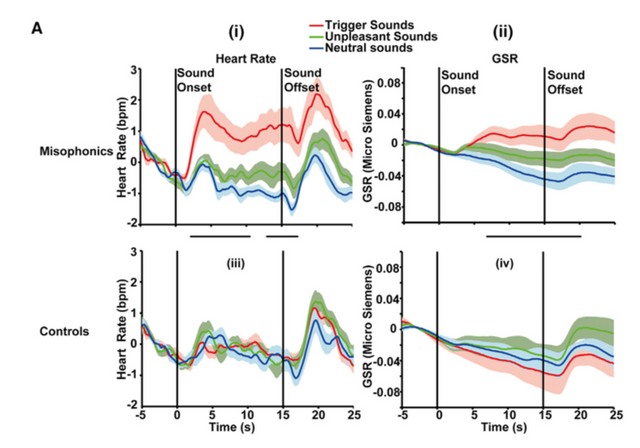
The Anterior Insular Cortex is described by the authors as:
"a core hub of the "salience network" that is critical for perception of interoceptive signals and emotion processing".
Interoceptive [2] means the internal bodily signals that we receive from internal organs etc. Another way to describe it is as the physical sensation of your body as a whole.
Greater activation of the AIC suggests both greater emotional activation of the brain in misophonics during trigger sounds and also might indicate a more internalised - literally visceral connection.
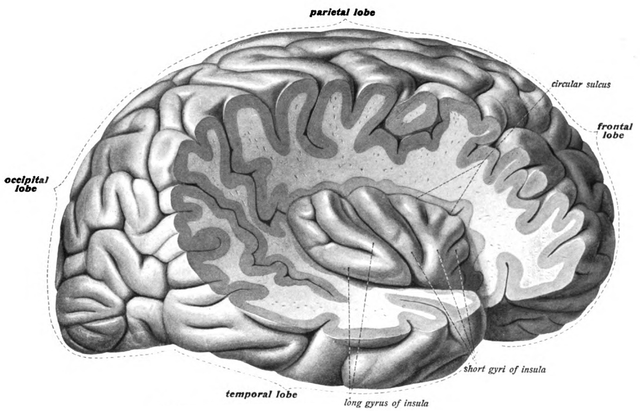
Image from Gray's Anatomy Showing the Insula
This is further highlighted by the regions which show increased connective activity during trigger sounds (see below).
Regions with increased connectivity to AIC in misophonics:
- Ventromedial prefrontal cortex (vmPFC).
- Postero-medial cortex (PMC).
- Hippocampus.
- Amygdala.
- Note this increased connectivity only occurred during trigger sounds.
These regions are all involved in various ways with emotional processing and regulation.
Further they are likely to be involved in the physical changes to heart-rate and GSR indicating a stress response.
The Default Mode Network
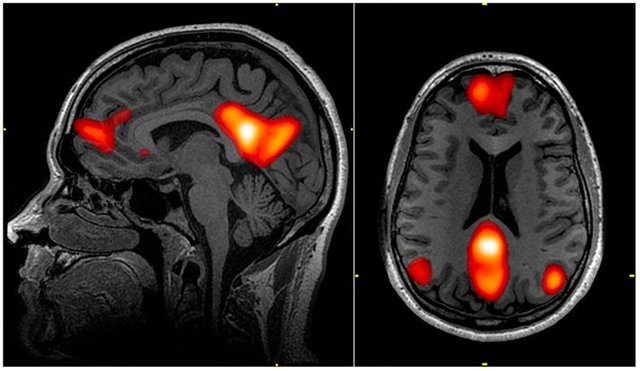
Image Source: Wikipedia (Public Domain)
The vmPFC and PMC are parts of what is known as the default mode network (DMN).
The DMN is normally involved with internal thoughts, memories and stimuli. In normal subjects it becomes less active when they are listening to external stimuli like sounds.
This suggests that for some reason misophonics are not able to reduce activity between the DMN and AIC.
According to the authors this likely heightens the emotional response and (in my opinion at least) may also be associated with that "visceral" sensation I described earlier.
These findings are also supported by the findings of heightened internal awareness (interoception) in the misophonics in the questionnaires.
The obvious question is whether the misophonia causes the interoception to change, or whether misophonics have a disorder of interoception which leads to developing misophonias?
A different type of study would be required to determine that.
Problems
This is actually a neat little study and I particularly like the extensive images they have used for illustration.
As is often the case this study uses a small sample size - the curse of much medical research!
That means replication with more studies or larger sample sizes is important before we can take this research further.
Also for reasons of brevity it seems that the authors did not include any of the raw data from which they constructed their graphs of subjective ratings.
It is always nice to be able to see this and there shouldn't be a huge amount given the small number of subjects. The graphs are useful but without the actual raw figures one can't check the calculations or spot certain anomalies.
They also seemed to leave out detailed recruitment information along with the inclusion and exclusion criteria.
These are always important to know to isolate or look for variables that might affect the results.
Further how did they find the people who suffer from misophonia? Were there any differences between the 2 groups? Without that information we can't really judge.
I would also be interested in finding out how common this "disorder" is. That would require large cross-sectional studies to determine.
If it is really common it might suggest some kind of evolutionary advantage - not necessarily due to the misophonia but perhaps due to the underlying mechanisms.
Perhaps a stronger response created a survival advantage in ancient humans?
Also are there other factors that make it more likely to occur e.g age, gender, certain personality types? Is there any association with autism and related disorders?
It would be interesting to find these things out.
A lot of the evidence in this study utilises fMRI and MRI data. We use it a lot in neurological studies.
I am not a medical physicist so can't really comment on the technical aspects as such and when doing this kind of research it is not unusual to get some input from the medical physics department.
It doesn't appear that the authors are doing anything non-standard here but I would love an expert opinion on this. If you are a medical physicist let me know what you think.
Finally, this research does not really assist in terms of suggesting a means of treating misophonia and that might be something else to look at in future studies.
Conclusion and TLDR version
This is a fascinating study that gives insight into an issue which I have personal experience of.
People who suffer from misophonia suffer a visceral hatred of certain commonplace sounds that seems out of proportion to the actual situation. This is often accompanied by reports of increased anger and a fight or flight response.
This study appears to confirm the presence of these symptoms in relation to trigger sounds but not other sounds in misophonic individuals.
Further by combining fMRI and MRI imaging data they confirm increased activity and connectivity in brain regions related to the integration and processing of internal physical sensations and emotions.
There also appears to be a reduced ability in misophonics to dampen down internal sensations while perceiving their trigger sounds.
More research is needed to confirm the results due to the small sample size and also to determine whether these abnormalities result in misophonia or vice versa.
It could also help to determine the prevalence of the disorder within the population and investigate potential treatment methods.
It is a good first step to find abnormalities but without a means of treatment it does not really help those who suffer from this.
Official Video Summary
There is a useful video summary released by the University itself (note there is no sound for the first 46 seconds) - N.B. unfortunately it seems to be listed as private now but I will leave it here in case they are updating/replacing it:
References
Kumar, Sukhbinder, Olana Tansley-Hancock, William Sedley, Joel S. Winston, Martina F. Callaghan, Micah Allen, Thomas E. Cope, Phillip E. Gander, Doris-Eva Bamiou, and Timothy D. Griffiths. 2017. “The Brain Basis for Misophonia.” Current Biology: CB 0 (0). Elsevier. doi:10.1016/j.cub.2016.12.048.
“Interoception.” 2017. Lab of Action & Body, Royal Holloway, University of London. Accessed February 3. http://www.pc.rhul.ac.uk/sites/lab/index.php/research-themes-projects/interoception/.
Thank you for reading
Before you go have you filled in the Coinbase form to list STEEM? It only takes a few seconds. THIS POST shows you how.
If you like my work please follow me and check out my blog - @thecryptofiend
Uncredited images are taken from my personal Thinkstock Photography account. More information can be provided on request.





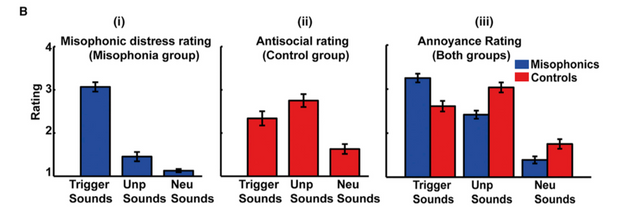
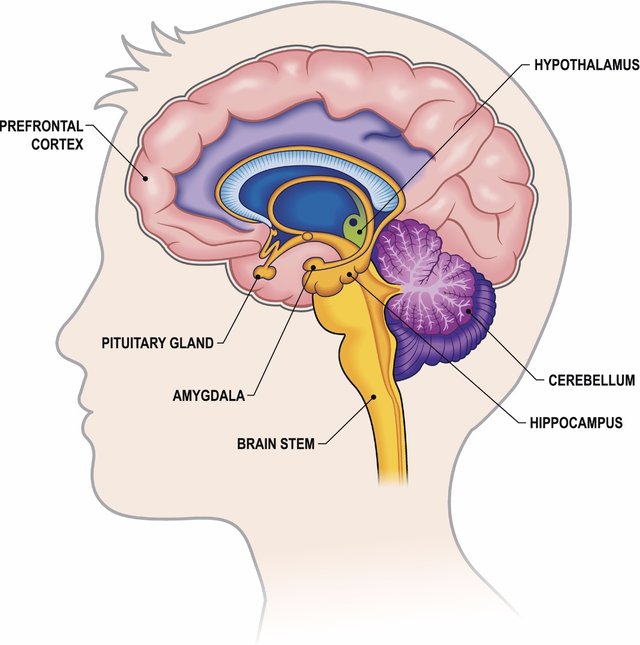



What an amazingly good post again! You keep on overdoing yourself! AWESOME!!! I am also highly sensitive to sounds and have observed the effects of sounds on my emotional states. Though I may not be afflicted of this condition, I could easily see how one could develop such a condition if left unattended.
Thanks again for the great quality, time and dedication to our platform. All for one and one for all! Namaste :)
Thank you for your support:)
This post has been ranked within the top 10 most undervalued posts in the second half of Feb 04. We estimate that this post is undervalued by $22.04 as compared to a scenario in which every voter had an equal say.
See the full rankings and details in The Daily Tribune: Feb 04 - Part II. You can also read about some of our methodology, data analysis and technical details in our initial post.
If you are the author and would prefer not to receive these comments, simply reply "Stop" to this comment.
Thank you:)
.
Thank you so much!
As for your hypothesis I think you make some superb points - I think you may well be right!
We need to see what future research shows - would be interesting to see the ties with ADHD and also autism spectrum disorders too.
Could be that evolution has selected out these traits and then as population expands it encourages them to be falsely triggered due to the close proximity we have to each other now.
This is such an interesting topic!
Being an Aspie, I've always been sensitive to light and sound and I have my quirky issues, but only in the past couple of years have I really developed a growing aversion to the sound of breathing while people are eating. It's amplified and gross and I just want to karate chop them in the throat to make them stop. Other sounds include scraping teeth on silverware and long nails clicking on a keyboard.
I'm curious - have you always had misophonia or do you think it became worse with age?
I think bizarrely it is getting worse - I have always had it to some degree but I seem to get in response to more sounds. The eating thing has always been there but the nail clipping issue is a recent development!
I completely understand the recent development thing! I'm just hoping it's not a stepping stone to dementia when/if I get old.
On the flip side, are there sounds that calm you more than others?
A dripping faucet drives me batshit crazy (because of sound and the idea of wasting water) but I could sit by a running stream all day.
Yes I think gentle rain is nice or ocean sounds! I hope it is not related to dementia!
me too...seriously - not so much for me because I'd be "out there" and probably oblivious - but I wouldn't want my family to deal with it.
True. It is tough for people when they are in the early stages but eventually you are past the point were you remember you have it at which point the main stress is on the family members. That is the paradox of dementias.
Thanks:)
You always find smth interesting! Great as always!
Thank you:)
Very interesting, fortunately I don't suffer from this. I say fortunately because I suffer from trypophobia, the fear of organic, dot like patterns, which can just about drive me crazy some days! Good, well researched post!
Interesting I have not come across trypophobia before I will need to look into it. You should share your experience in a post if you have not already.
https://steemit.com/phobia/@onetree/trypophobia-fear-of-dots-no-pictures-in-this-article
Cool thanks:)
For me, sounds that does this is screeching sound like those metal rubbing against metal.
Yes that is horrible too!
Had such effect at school, when heard the sound of chalk on blackboard. Thanks God I didn't have to suffer for it at univestity due to it's specific. Thank you for an interesting post!:) Following you:)
Thanks. That must have been torture!
It definetly was:( With no escape. Now as an artist I use chalk mixed with charcoal sometimes, but when I do I have my headphones on with some heavy-metal in them:)
Good strategy - if you can block it out it is as good as escape.
Super postman
With me being on public wi fi a lot -- I am finding myself continually annoyed with all the noise around me but I do understand the clinical aspect to this.
Have a good nite man.
You too mate! Thanks:)